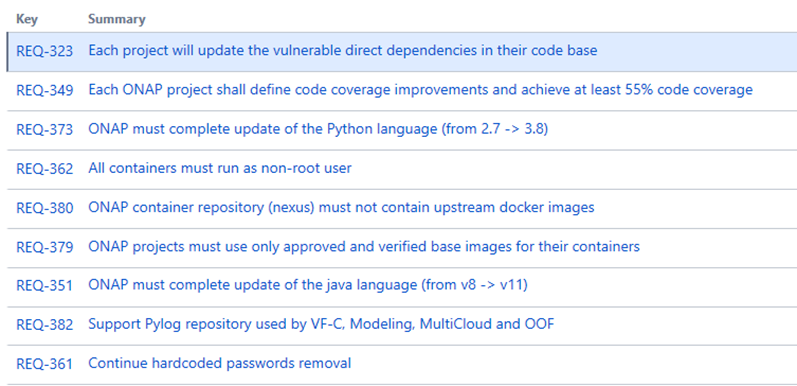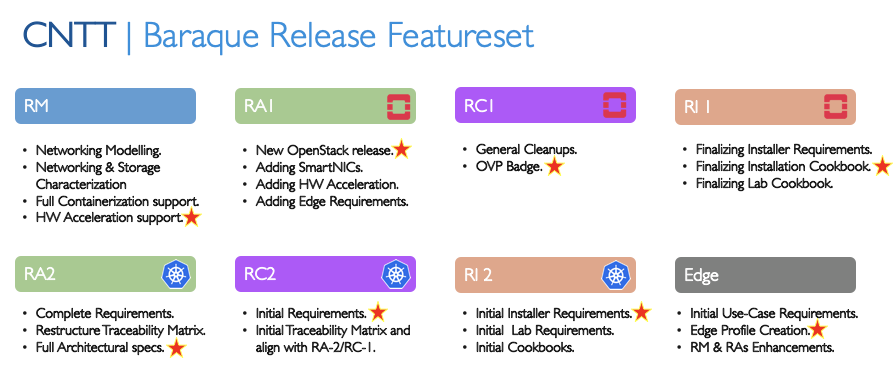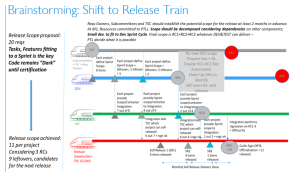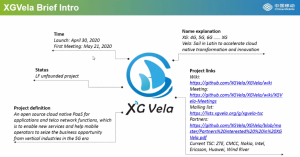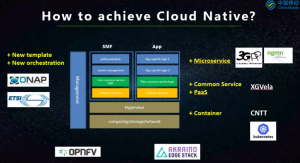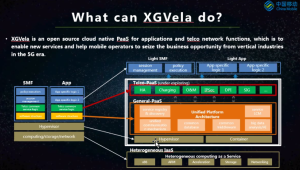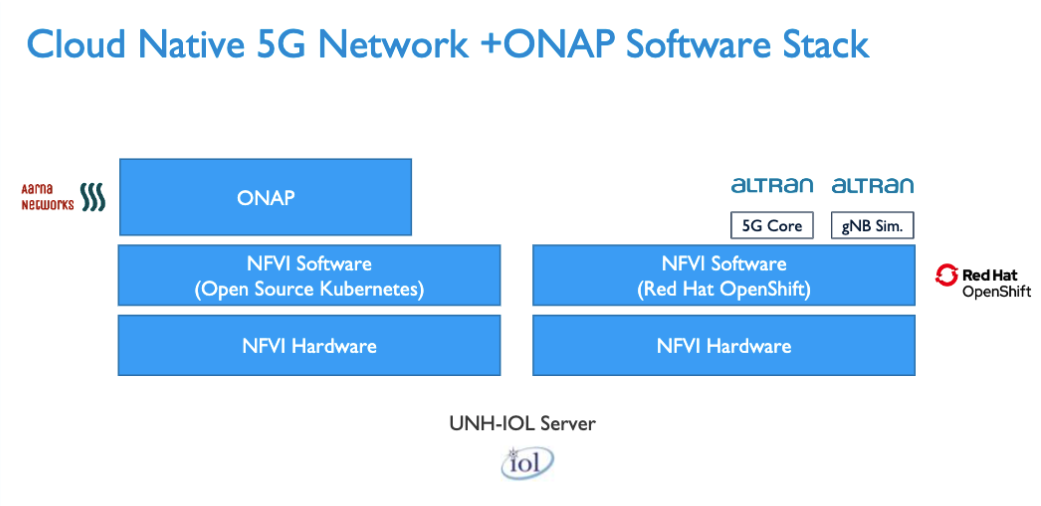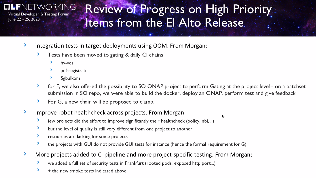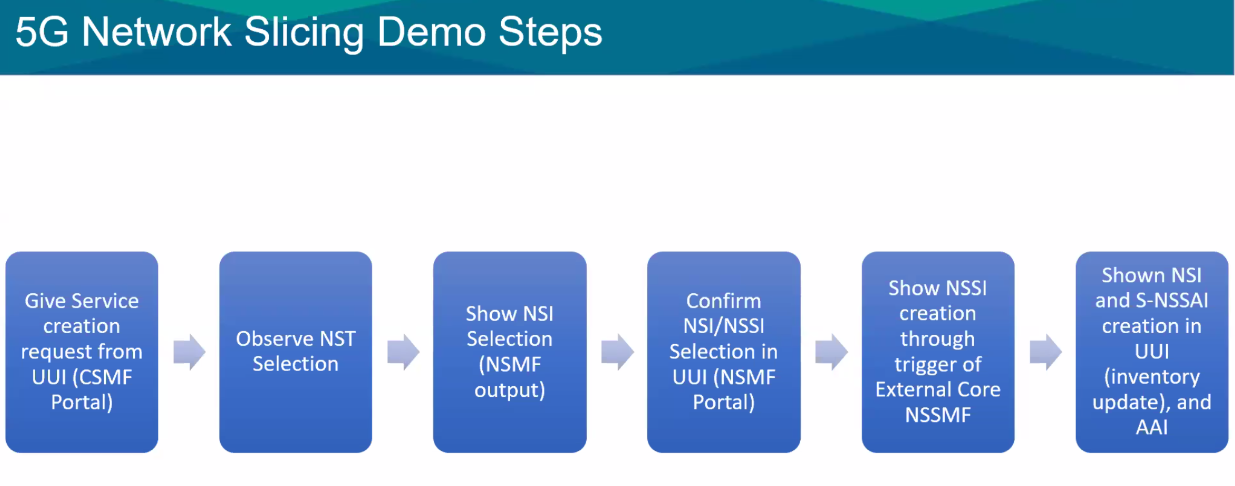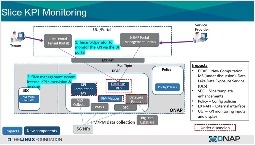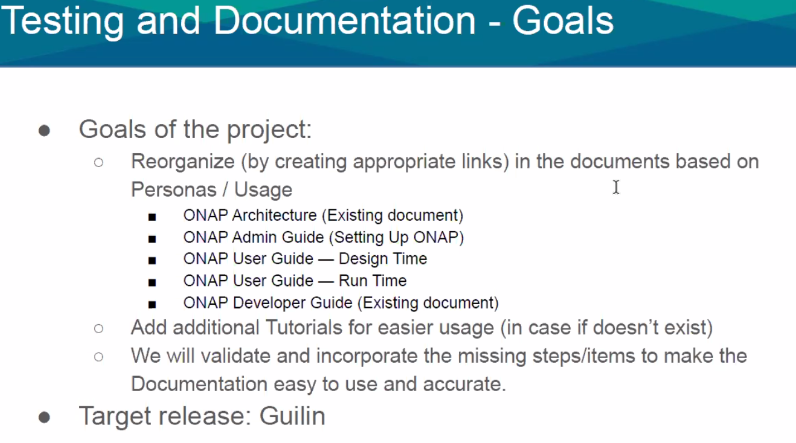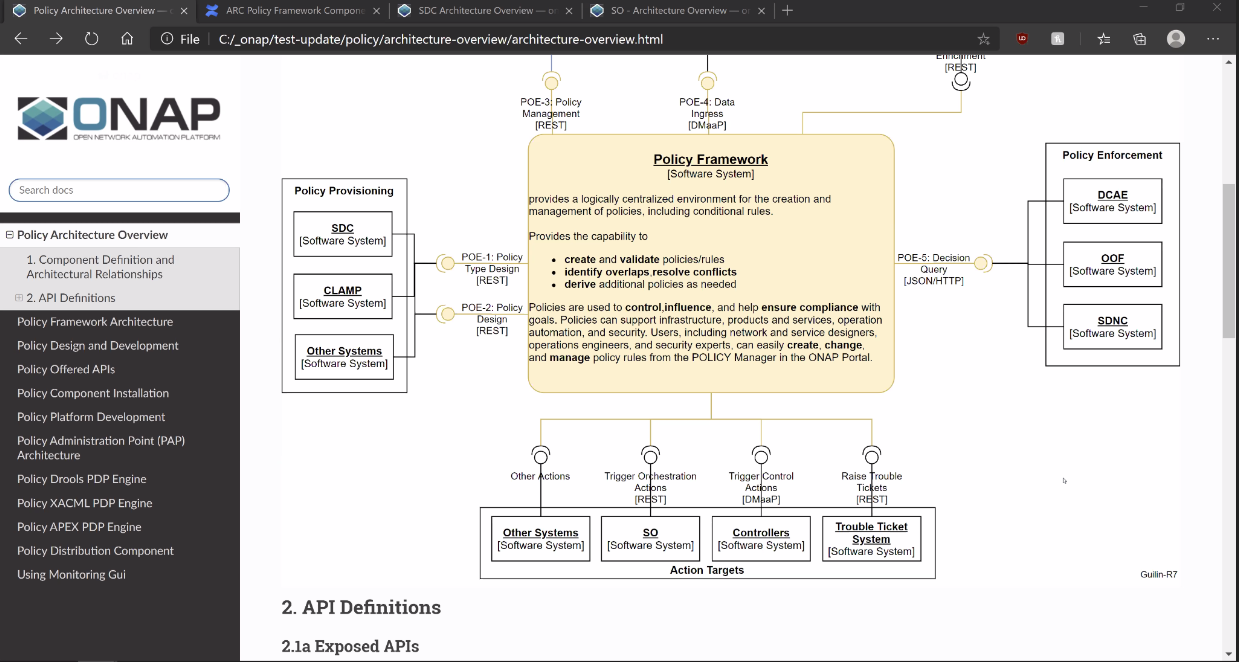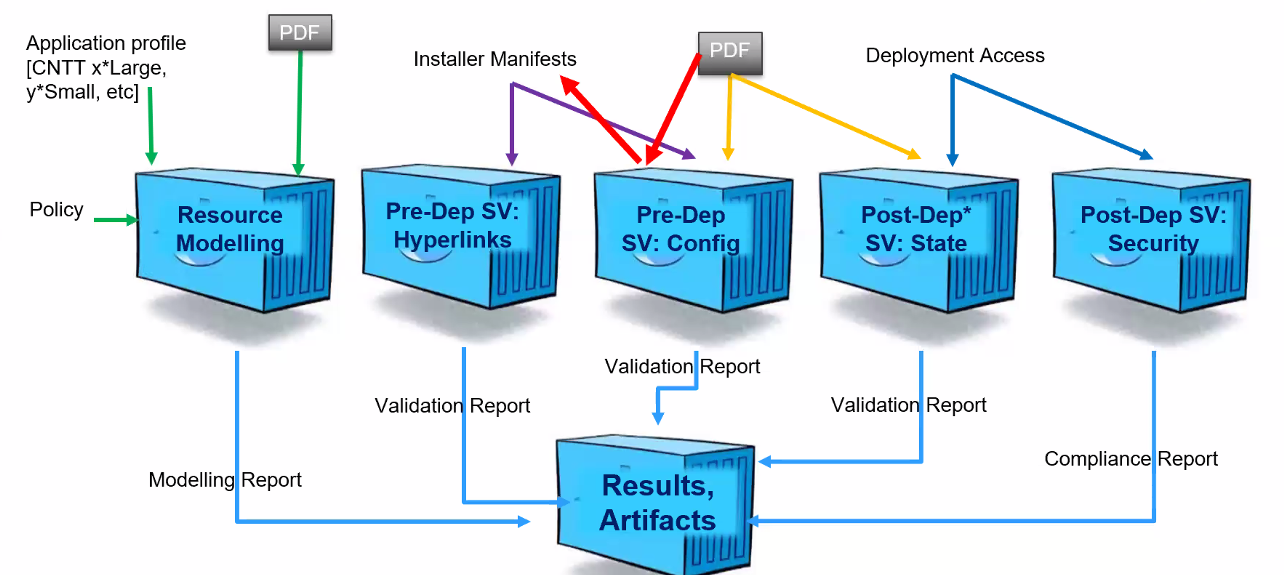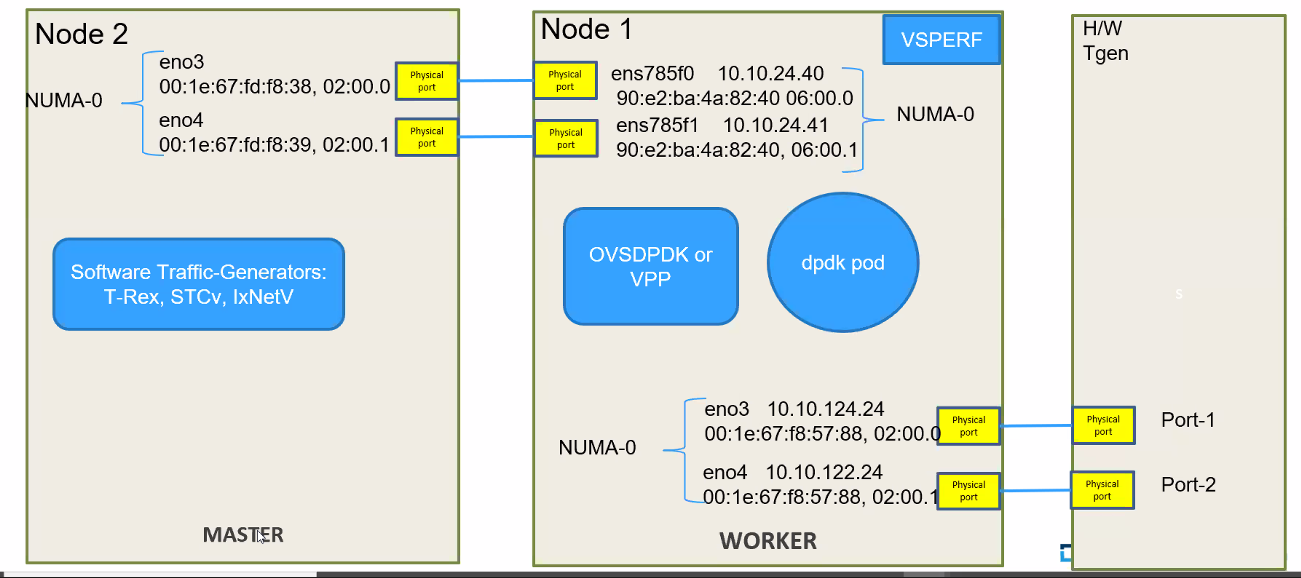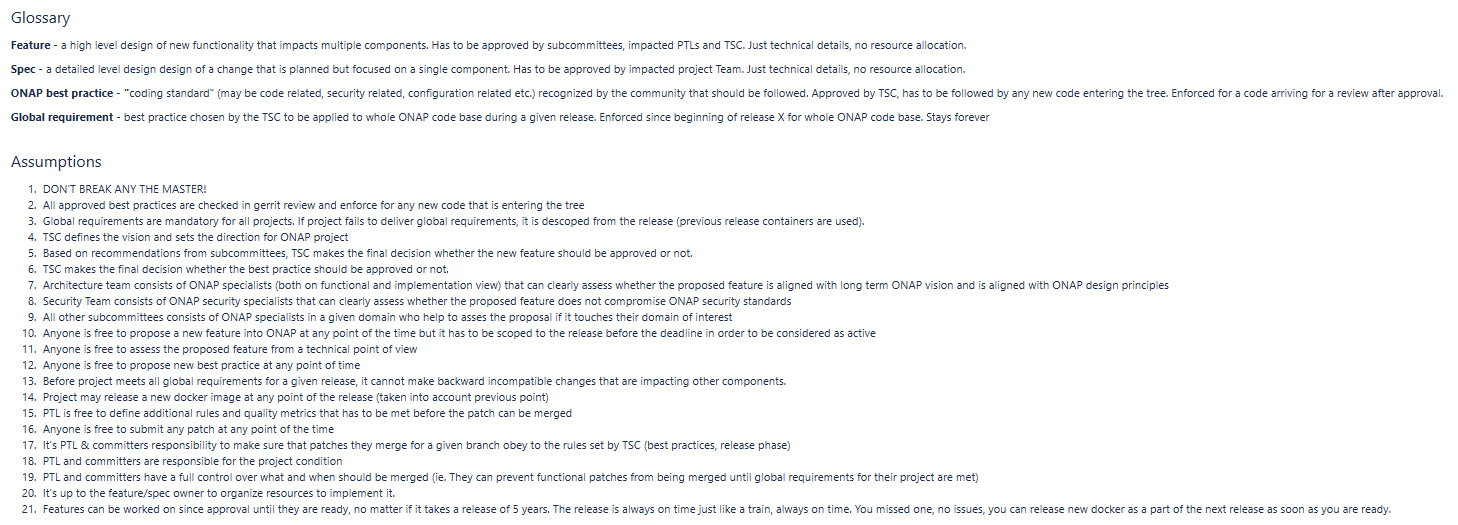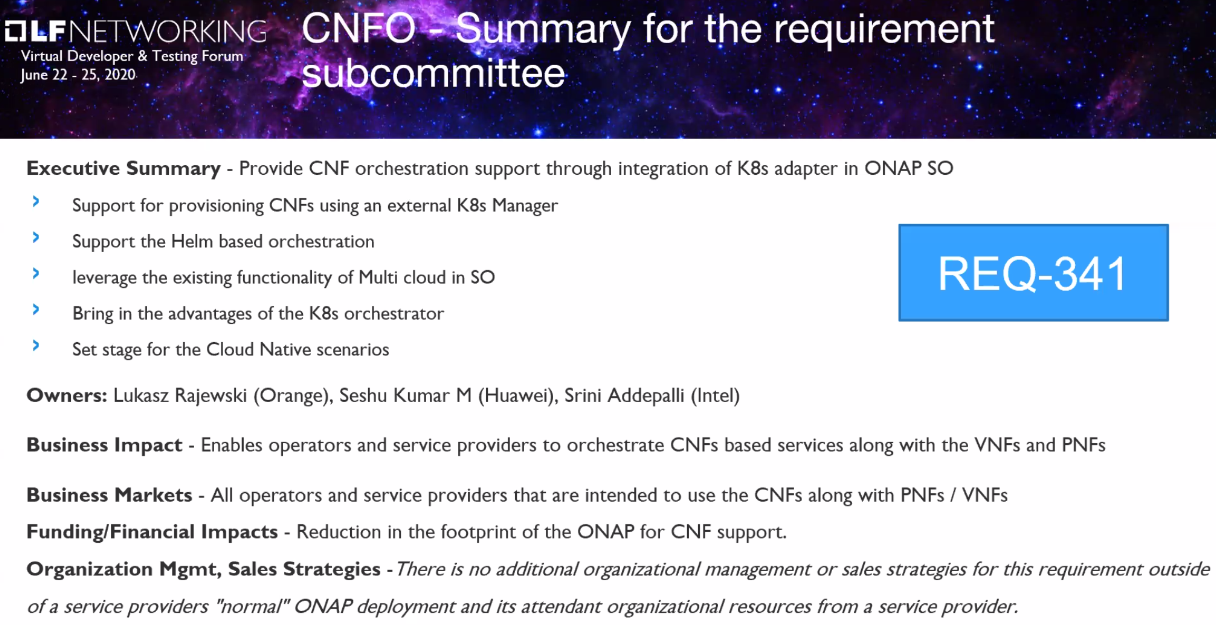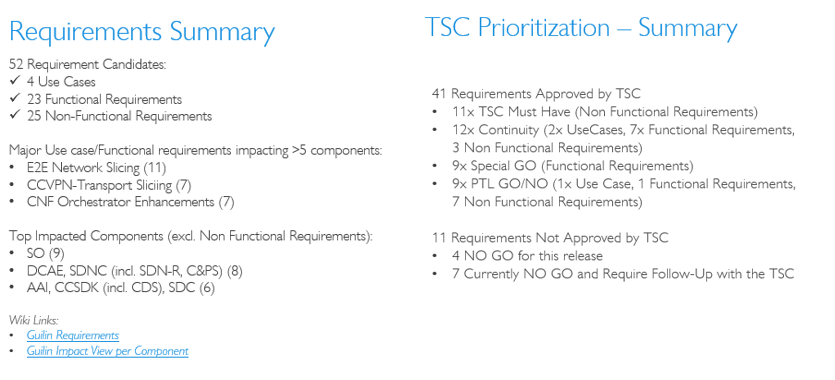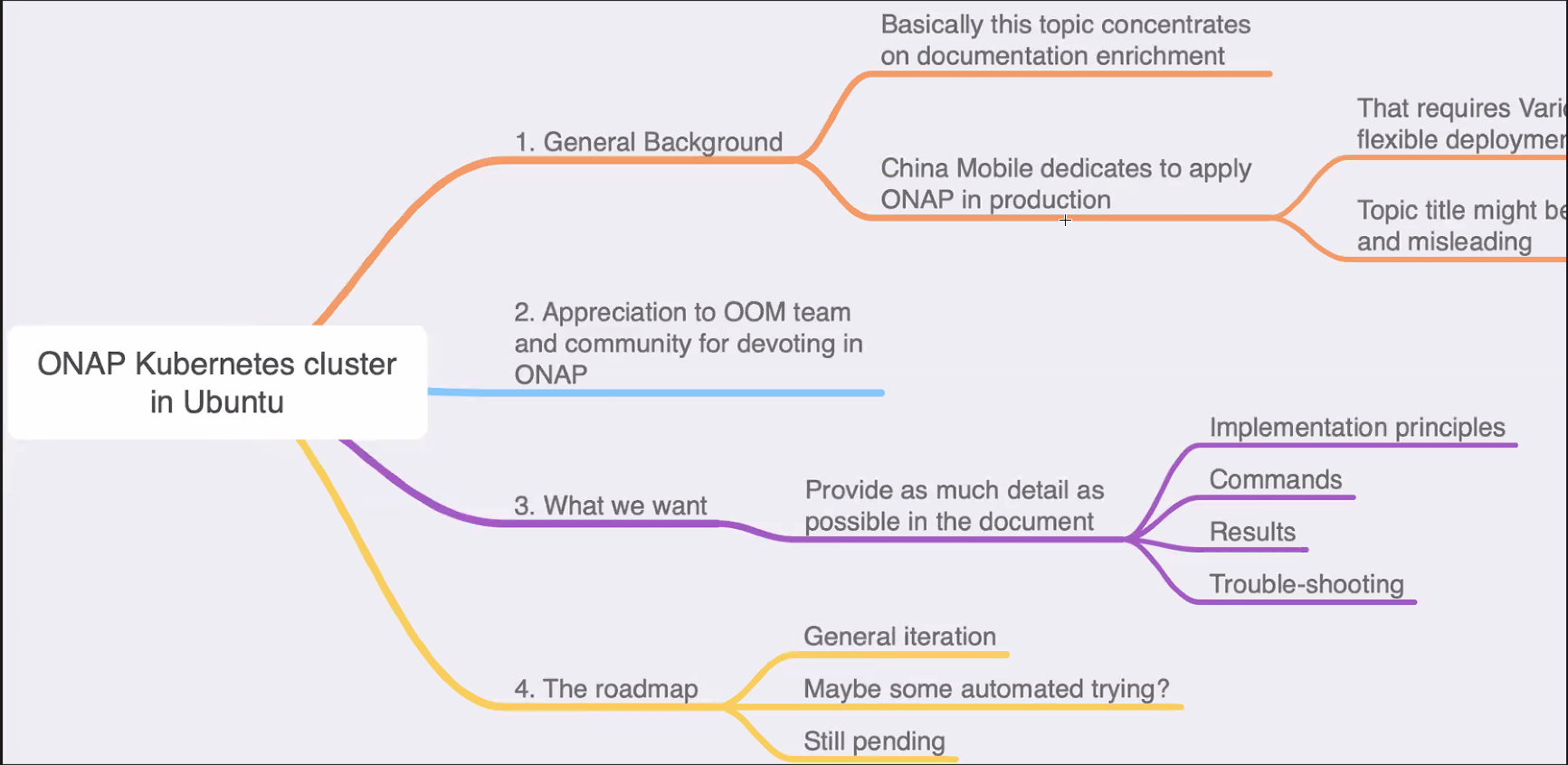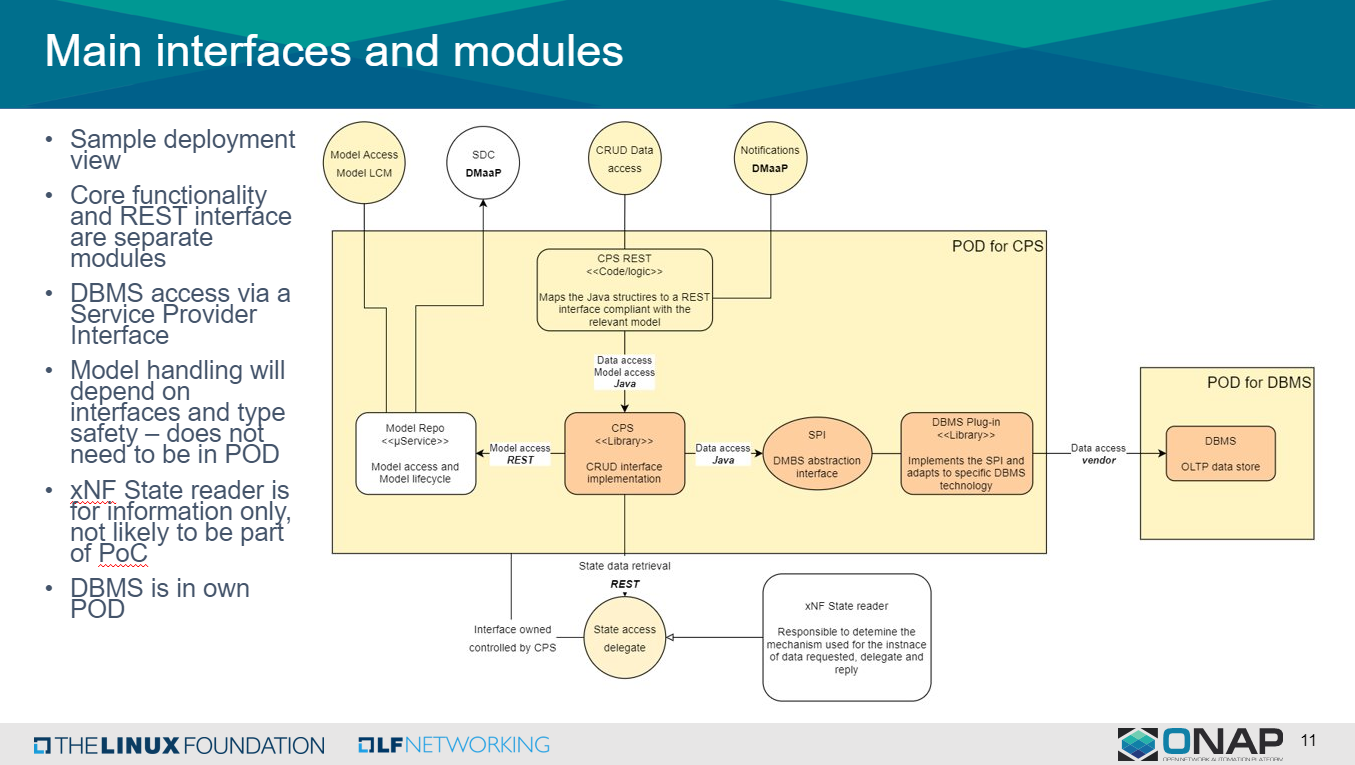June 22nd, 2020 - Day 1
ONAP Track | Key Points | Challenges | Next Steps/Action Items |
|---|---|---|---|
Track: Requirements Subcommittee meeting and presentation of Guilin planned work Presenter/Moderator: Alla Goldner |
|
|
|
Track: License compliance & how to deal with it? Presenter/Moderator: Krzysztof Opasiak / Catherine Lefevre | Details regarding Non functional requirements REQ-379, REQ-380 - https://wiki.onap.org/display/DW/License+compliance The list of "Base Image statistics" can be enhanced as long as the ONAP Community will maintain it. |
| |
Track: Integration Status update: what's planned internally Presenter/Moderator: Morgan Richomme |
|
| |
Track: Modeling Subcommittee Meeting https://wiki.onap.org/display/DW/Modeling+2020-06-22+Special+Virtual+Face+to+Face+Meeting | Reviewed current modeling activities and candidate modeling requirements for Guilin. The following topics were also presented: 1 Modeling process 2 Policy model 3 Slicing model 4 CNF Inventory Modeling 5 CNF ETSI modeling overview 6 Modeling of Geolocation information Recording may be found at: LNF_June_vDTF-ONAP-_Modeling_Subcommittee.mp4 | invite to join those discussions | |
Track: Policy Framework Guilin Prioritization Presenter/Moderator: Pamela Dragosh |
| https://wiki.onap.org/display/DW/2020+Frankfurt+Tutorials | |
| Cross Community Track | Key Points | Challenges | Next Steps/Action Items |
Track: Help Recruit more Developers to LFN Projects! Presenters/Moderators: Jason Hunt , Abhijit Kumbhare , Al Morton , Catherine Lefevre , Morgan Richomme , Ranny Haiby |
|
| |
| CNTT/OPNFV Track | Key Points | Challenges | Next Steps/Action Items |
| OPNFV Kick-off, and Round-Robin Project Reviews | So far, so good! | Need to use this Wiki Page for Day two and beyond, for notes etc. | |
CNTT Kickoff with Baraque Release |
| Please attend all CNTT sessions and participate in the discussion. |
June 23rd, 2020 - Day 2
Cross Community Track | Key Points | Challenges | Next Steps/Action Items |
|---|---|---|---|
Track: Shift to Release Train Presenters/Moderators: Catherine Lefevre | ›The Challenges from LFN Projects ›Release Cadence in Other Open Source projects >Shift to Release Train & Brainstorming Wiki notes: Shift to Release Train 2020-06-23 | ›How can we release more frequently, smaller scope without impacting the SW quality? ›How can we change the waterfall-ish development model? ›How can we get enough details about candidates requirements prior the release? ›How to manage the release in case of people turn-over? ›How to handle the scope and maintain a balance between Usecase/Functional reqs (attractive) and Non functional reqs (less sexy)? |
|
Track: XGVela Presenters/Moderators: Qihui Zhao |
| ||
Track: Cloud Native in Telecom Cloud Presenters/Moderators: Qihui Zhao, Ying Li |
|
| |
| ONAP Track | Key Points | Challenges | Next Steps/Action Items |
Best practices for updating software components Presenters: Pawel Pawlak Amy Zwarico | Reviewed mandatory upgrades to Java 11 and Python 3 for all projects Migration of ONAP to standard infrastructure versions: Docker, Kubernetes, OS images, databases, etc (see Database, Java, Python, Docker, Kubernetes, and Image Versions) Updating vulnerable direct dependencies:
| Resources to do the non-functional work Potential dependencies that conflict with new versions | SECCOM will have representative at the weekly PTL call to answer questions PTLS and others are always welcome to attend the SECCOM weekly on Tuesdays to raise issues PTLs secure resources and plan to identify show stoppers as soon as possible (M1) |
EUAG Operator Survey & In-Depth Analysis On Consumption Model Presenters: Atul Purohit | Presented End User Advisory Group's survey on various ONAP consumption models, which led to creation of EUAG white paper Key topics covered - › Introduction – EUAG › What Survey & Why › Survey Questions, Deductions › Recommendations › Paper & Wrap - Up | None |
|
OOM Status update: what's planned internally Presenters/Moderators: Sylvain Desbureaux, Krzysztof Opasiak | Review of the planned OOM changes : Support of Helm V3 Kubernetes V1.17 (or 1.18) Migrate to Seccom recommended Versions Update defaults (use Ingress, Storage Class, Hardened OS) | Might be breaking gating during changes, impact deployments | check if Helm V3 requires Kubernetes v1.17+ |
OOM Status update: consequences on other components Presenters/Moderators: Sylvain Desbureaux, Krzysztof Opasiak | Review of the required changes on components helm charts VS requirements presentation of changes, use of templates, adding appender to Logback to support STDOUT as additional output Container that do not contain ONAP code should not be hosted on Nexus No Root access to DB Application config should be fully prepared before starting the container Containers must crash properly when a failure occurs No more Nodeports AAF optional (component should work without AAF even in degraded mode) HTTPS is mandatory but should be configurable (disable in case of Service Mesh as this will be offloaded to Service Mesh) Container RootFS should be mounted as ReadOnly Commit message rules for OOM | AAF removal or optional / POC SMesh | SecCom to follow up and define what disabling AAF means |
Requirements Traceability: Initial Request through TSC Approval Presenters/Moderators: Alla Goldner, Chaker Al-Hakim, Pawel Pawlak, Pamela Dragosh, David McBride, Catherine Lefevre |
wiki: 2020 June vDTF ONAP Requirements Traceability: Initial Request through TSC Approval |
|
|
Presenters/Moderators: Konrad Bańka Samuli Silvius Lukasz Rajewski | The presentation covers Frankfurt CNF instantiation improvements on vFW use case example
Use Case Doc: https://onap-doc.readthedocs.io/projects/onap-integration/en/latest/docs_vFW_CNF_CDS.html#docs-vfw-cnf-cds |
|
|
Orchestration of 5G CNFs using Multicloud K8s plugin Presenter: Sandeep Sharma |
|
| |
Python ONAP SDK Presenter: Michal Jagiello | Version 1.0 of the SDK was released and will be available using pip. Presentation provided an overview of the project capabilities:
SDK requires Python 3.7 or higher and was tested with ONAP Frankfurt. |
| |
Frankfurt Post Mortem Presenter : David McBride | Review Frankfurt Schedule changes & pain points
| Release more frequently VS time |
|
Presentations given on the 5G & PNF Use Cases https://wiki.onap.org/display/DW/Guilin+%28R7%29+-+Use+Cases (Presentation Slides are there also) There are many dedicated 5G/PNF Use Case deep dives in the DDF The U/C Realization call will engage PTLs: https://wiki.onap.org/display/DW/R7+Use+Case+Realization+Meetings+MoM Overview of the Use Case Process Page (Way of Working WoW) https://wiki.onap.org/pages/viewpage.action?pageId=79204390 Andy Mayer gave an overview of the Generic Information Template: https://wiki.onap.org/display/DW/Generic+Information+Element+Template | |||
| The code (as demonstrated) along with test scripts and swagger documents will be added to the multicloud/k8s repository soon. | ||
| CNTT Track | Key Points | Challenges | Next Steps/Action Items |
| Performance (Joint with OPNFV) |
|
| |
| Traceability Test Cases (Joint with OPNFV) |
| ||
| Use cases of SDN solution |
| ||
| Field Trial Status (Joint with OPNFV) |
| ||
| Next CNTT OpenStack Release & Cyborg Acceleration Mgmt |
| As a result of the discussion, the next step will be to present an option of moving straight to Ussuri. Action on Pankaj Goyal | |
| OPNFV Track | Key Points | Challenges | Next Steps/Action Items |
| <Many CNTT meetings were Joint with OPNFV Today!> | See above - Scheduling was a non-challenge again today! | ||
| OPNFV TSC Meeting |
Let's play Twister! | Need to clarify OPNFV interactions with CVC/OVP: this entity was not formed yet at the time OPNFV was Chartered. | |
OpenDaylight Track | Key Points | Challenges | Next Steps/Action Items |
ODL Micro Status & Next Steps |
|
| |
ODL Platform API Changes and impact to downstream consumers |
June 24th, 2020 - Day 3
ONAP Track | Key Points | Challenges | Next Steps/Action Items |
|---|---|---|---|
Track: E2E Network Slicing Session 1 Presenters/Moderators: LIN MENG | Content: Slides are available here and here.
Presentation Slides are available here and here. Recording is available here. Comments/Feedback
| ||
Track: E2E Network Slicing Session 2 Moderators: Presenters: | |||
Track: E2E Network Slicing Session 3 Presenters/Moderators: LIN MENG Swaminathan Seetharaman | |||
Track: 5G OOF SON use case: Overview & Demo Presenters/Moderators: Demo: @Reshmasree | |||
Track: Docs/Migration Presenters/Moderators: Sofia Wallin, Jessica Wagantall |
| ||
Track: Documentation guide Preseenters/Moderators: Sofia Wallin/Eric Debeau | image2020-6-25_14-16-14.png | ||
Track: Documentation improvement plan for the Guilin release Presenters/Moderators: Amar Kapadia | |||
Track: Architecture Component Views in Readthedocs Presenters/Moderators: Ciaran Johnston, Tony Finnerty, Jeff Van Dam, Sofia Wallin | Great improvements from moving content from Confluence (onap wiki) to ReadTheDoc | ||
Track: Release Note Content Presenters/Moderators: Sofia Wallin |
| ||
| Track: Reference CNF development journey and outcomes Presenters/Moderators: Victor Morales |
|
| |
| OPNFV Track | Key Points | Challenges | Next Steps/Action Items |
Cloud Software Validation - Part of OPNFV CIRV project Sridhar Rao |
| Form of UI and exposure of results: many possibilities (REST, cache in X-testing, others) PDF is a "big" PDF, includes many aspects beyond OPNFV PDF. Today, checking Airship deployment and debug with logs (find root cause). Other deployments ?? Security Checks: Some tools in Functest, Ansible Security Hardening has possibilities, Cedric will have a look in Openstack. | By early August, should have Airship Manifest complete. Results API will expand storage beyond current local storage, to X-testing, Test-API, etc. |
| K8s: Multi-Interface Container Network Benchmarking in VSPERF Sridhar Rao | Background information in Slides from April Event (links in the slides), Thanks to K8s Networking Experts! This is Mostly a Hands-on DEMO!
| Pod must be running DPDK, or other performance enhancing technology. Still exploring CPU configurations (optimization). Currently need to add flows in vSwitch manually. Need Expert Help! Queue configuration on Virtual Ports! Also Hugepage configuration. | Using Ixia HW Traffic generator in very near future. Will be running more comparison tests when satisfied with configurations. Jeff Hartley offered to help! |
OVP 2.0 Cloud Native Operator Panel Moderator: Marc Price |
| ||
Joint Topic: OPNFV and CNTT: OPNFV Release Process 2.0 JOINT with CNTT David McBride |
Requirements Vetting Process | Finding more time to close on this discussion: Proposal is to re-allocate time from Thursday's Agenda, Joint Topic Right after the 30 minute Break! | Additional Notes/Questions: What Artifacts are we Releasing?
|
OpenDaylight Track | Key Points | Challenges | Next Steps/Action Items |
| ODL transportPCE Magnesium Retrospective | This retrospective presented a quick overview of TransportPCE new functionalities introduced in Magnesium. It was followed by a status on the developments done and some feedbacks on the features introduced by OpenROADM and the community ( OpenROADM OTN support, SpotBugs / checkstyle enforcement and doppelgangers, netconf notifications ) | OTN support hardened for Aluminium Contributors growth | involve more reviewers and commiters rationalization of project features for OTN |
| ODL BGPCEP Reliability & Scale |
|
| |
| ODL Usability Review | A quick usability review of the OpenDaylight Usability was covered in this session including what works well, what does not (development & deployment challenges). This was followed up with suggestions for improvements - from a low hanging fruit to bigger architecture improvements like a more loosely coupled platform. | ||
| ODL Project Status | The discussion concentrated around how to get more developers on boarded. There were many suggestions including having a dedicated public face for helping new developers. A key point that was made was:
| ||
| CNTT Track | Key Points | Challenges | Next Steps/Action Items |
| Edge Deep Dive |
|
| Clarify the term profile in relation to hardware profile or workload profile |
| Networking Focus Group |
|
|
|
| OVP Phase 2.0 Panel |
|
June 25th, 2020 - Day 4
| ONAP Track | Key Points | Challenges | Next Steps/Action Items |
|---|---|---|---|
|
| ||
Track: CNF Orchestration through ONAP Presenters/Moderators: Seshu Kumar Mudiganti, Lukasz Rajewski |
|
|
|
| Track: Closed Loop Target Reference Architecture and Rel G steps |
|
| |
Track: Guilin Release - TSC Prioritization Presenters/Moderators: Catherine Lefèvre and ONAP TSC | Big thanks to all the Requirement Owners for their submission ! Dear ONAP Community - Continue to support our project teams through your engagement; They have a lot to accomplish prior our next milestone (July 9th, 2020) !!! Heartily Thank You |
| |
Track: Writing tests with Robot Framework Presenter: Marek Szwałkiewicz | Introduction, best practices and hints on writing tests with Robot Framework During this presentation I tried to familiarize participants with Robot Framework, show some shortcuts that can be taken and show the Robot wrapper for Python ONAP SDK in action.
Presentation: LFN_June_vDTF_Robot.pdf |
| |
| Track: Set up Kubernetes ENV guide in Ubuntu Presenters/Moderators: |
| ||
Track: Service Mesh for RBAC and security PoC presenters: Sylvain Desbureaux Krzysztof Opasiak | Service Mesh PoC will require just few changes on the component:
|
|
|
| Configuration & Persistency Service (C&PS) Project Overview & Model-Driven C&PS PoC | C&PS Project Page at: https://wiki.onap.org/pages/viewpage.action?pageId=81406119 C&PS DDF Presentations at: https://wiki.onap.org/pages/viewpage.action?pageId=81406119 Weekly Meetings at: https://wiki.onap.org/pages/viewpage.action?pageId=84644224 C&PS Project Proposal: https://wiki.onap.org/pages/viewpage.action?pageId=71834216 Overview of C&PS and Model Driven C&PS PoC | Developing PoC in R7 See MD C&PS PoC Slides at https://wiki.onap.org/pages/viewpage.action?pageId=81406119 | |
Model Driven Configuration and Persistency Service PoC Deep Dive Presenter: Tony Finnerty | YANG is Primary input and native language of the CPS |
| |
OpenDaylight Track | Key Points | Challenges | Next Steps/Action Items |
| Sync OpenDaylight releases and LFN infra migrations | Open discussion on how we can improve the LFN infra migration and ODL release cycles. Those migrations affect the overall efficiency of the community but not only.
|
| |
ODL BGPCEP Magnesium Retrospective and Roadmap for Aluminium | This retrospective presented a quick overview of Graph & Algo features introduce in BGPCEP project for compliance to RFC 5440. A short demo highlighted the new functionalities. The presentation also covered the roadmap for Aluminium release and reviewed new features that will be introduced to provide a Path Manager service. | RFC 5440 support Growth the community Next challenge for the project | Design a PTL and add more reviewers / committers |
ODL Service Automation Framework (SAF) | Service Automation Framework is a new project in OpenDaylight that leverages Workflow concepts to simplify Service provisioning. This session presented an overview of SAF project and have a discussion around roadmap items. | ||
ODL Platform Aluminum updates and Silicon lookahead | This talk provided details on what platform updates will be part of the Aluminum release. Also covered were potential platform updates in the next release, effectively doing some planning for Silicon. | ||
| CNTT Track | Key Points | Challenges | Next Steps/Action Items |
| RI-2 DeepDive |
|
|
|
| RC-2 DeepDive | Bill Mulligan led the session on RC-2 Deep Dive
|
|
|
| CNTT/OPNFV Release Sync |
| ||
| CNTT Security |
|
|
|
| OPNFV Track | Key Points | Challenges | Next Steps/Action Items |
OPNFV INFRA Work Group Update Trevor Bramwell Sawyer Bergeron |
| Lab folks are seeking HW quotes, but this has stalled (for many reasons that seem to be related to COVID-19). Need to Figure out a way to get quotes before the funding goes away! | |
Second Session of Joint Topic: OPNFV and CNTT: OPNFV Release Process 2.0 JOINT with CNTT David McBride |
| Testers who won't experiment... | More "Spirited discussion" at the OK Coral |
| Tungsten Fabric Track | Key Points | Challenges | Next Steps/Action Items |
| TF Integration with ONAP |
| ||
| Making TF Cloud Native | |||
| Move Upstream DPDK for TF |
